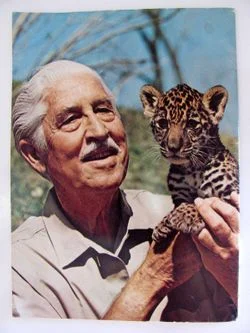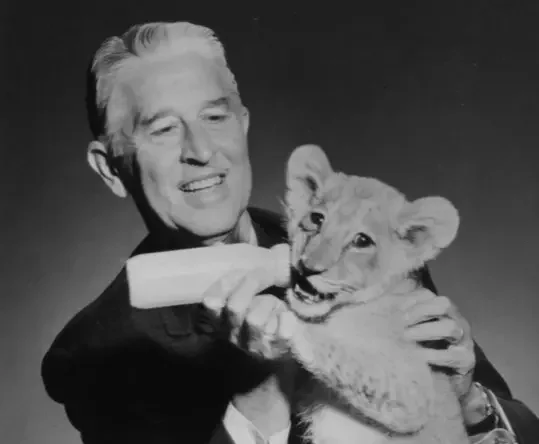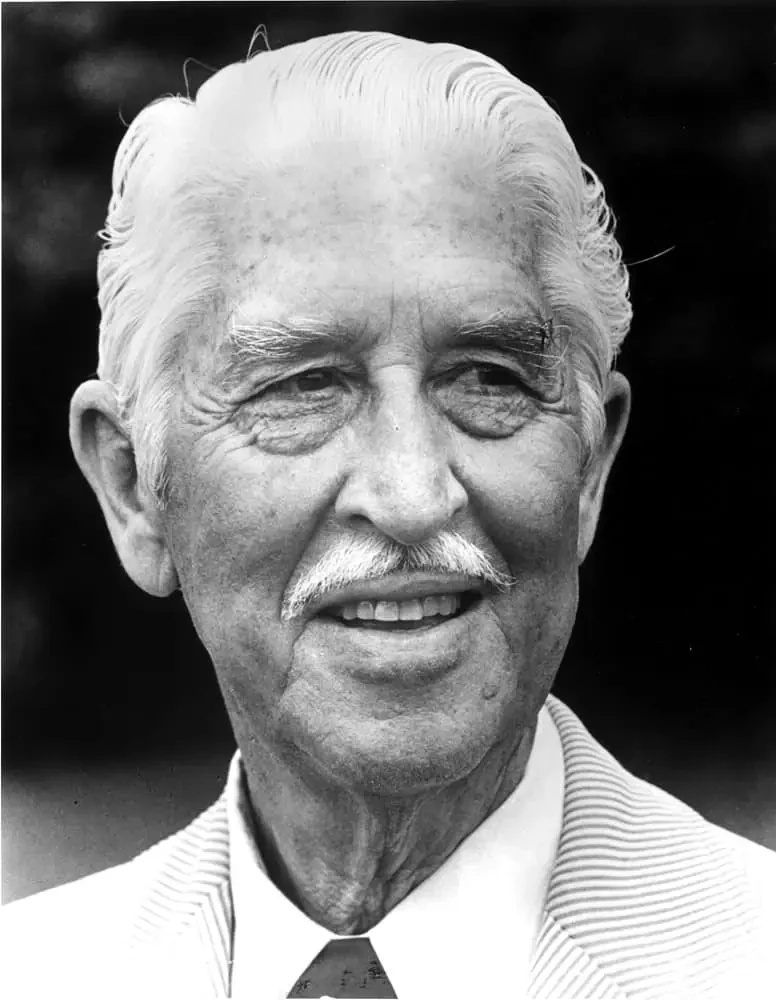The Life and Legacy of an Iconic Zoologist and TV Personality
R. Marlin Perkins, renowned zoologist and television host, made an indelible impact on wildlife conservation and public awareness of animals. His role as the second full-time director of the Saint Louis Zoo from 1962 to 1970 and his popular TV programs brought animals and nature into households across the United States. Let’s explore the life and contributions of Marlin Perkins, from his childhood fascination with animals to his lasting legacy.
Early Life and Love for Animals
Born on March 28, 1905, in Carthage, Missouri, Marlin Perkins developed a deep love for animals from a young age. After his mother, Mynta Mae (Miller) Perkins, passed away, he moved to his aunt’s farm, where he began his own “zoo,” which featured snakes, toads, and small critters he found around the property. These early years on the farm fueled his passion for wildlife, particularly snakes.
As he grew older, Marlin’s fascination with animals only intensified. After returning to live with his father, a respected lawyer and judge, he attended Carthage High School and later enrolled at the University of Missouri, where he studied zoology. However, his desire to work hands-on with animals led him to leave college and apply for a position at the Saint Louis Zoo.
Beginning His Career at the Zoo in Saint Louis
At just 21, Marlin joined the Saint Louis Zoo, earning a modest $3.75 a week as a groundskeeper. His enthusiasm for reptiles quickly caught the attention of the zoo’s director, George Vierheller, who allowed him to manage the zoo’s small reptile collection. In this role, Marlin expanded the exhibit and gained public interest, eventually leading to the approval of a permanent reptile display. Within a few years, he was named the zoo’s Curator of Reptiles and grew the collection to over 500 animals.

Rise to Fame: Zoo Parade and Wild Kingdom
In 1938, Marlin Perkins became the director of the Buffalo Zoological Gardens in New York, followed by the Lincoln Park Zoo in Chicago in 1944. It was in Chicago that he began his television career. His first program, Zoo Parade, showcased animals from Lincoln Park Zoo and was broadcast live. Through this program, Marlin became a household name, educating viewers on the behavior and habitats of various animals. His calm demeanor and natural storytelling abilities made him a beloved television figure.
When Marlin returned to the Saint Louis Zoo as director in 1962, he began working on Mutual of Omaha’s Wild Kingdom, a groundbreaking show that took viewers into the wild with Marlin and his team. The show quickly became a sensation, running for over two decades and earning four Emmy Awards. From exploring jungles and savannas to capturing rare animal encounters on film, Wild Kingdom helped to foster an appreciation for wildlife conservation among millions of viewers.
A Champion for Ecology and Animal Conservation
Long before the modern environmental movement, Marlin Perkins advocated for ecological preservation. He used his platform on Wild Kingdom to stress the importance of protecting endangered species and respecting all forms of wildlife. His unique approach combined thrilling adventures with messages about conservation, teaching viewers that extinction has lasting consequences. Wild Kingdom aired in over 40 countries and reached more than 200 television stations in North America, making Perkins a global ambassador for wildlife education.
Notable Expeditions and Achievements
In 1960, Marlin joined Sir Edmund Hillary’s Himalayan expedition, where he was tasked with investigating sightings of the Yeti, also known as the Abominable Snowman. Through scientific analysis, Marlin concluded that the tracks attributed to the creature were likely caused by smaller animals whose prints had been enlarged by the sun.
Marlin’s contributions earned him numerous honors, including an American Education Award in 1974 and honorary doctorates from several universities. Marlin continued to be actively involved in conservation efforts until his death in 1986, even after he retired as the director of the Saint Louis Zoo in 1970.
Marlin Perkins Society: A Lasting Legacy
In 1991, the Saint Louis Zoo established the Marlin Perkins Society to continue his work in conservation. The society focuses on preserving endangered species, supporting wildlife research, and educating future generations about the importance of biodiversity. Perkins’ legacy lives on through these efforts, ensuring that his dedication to animals and ecology endures.
Honoring the R. Marlin Perkins Award for Excellence
The Association of Zoos & Aquariums (AZA) honors Marlin Perkins through the R. Marlin Perkins Award for Professional Excellence. This prestigious award recognizes AZA members who have demonstrated a commitment to conservation, education, and animal welfare. Recipients of this award follow in Perkins’ footsteps, contributing to the advancement of zoological sciences and fostering a greater understanding of wildlife.
Beginning His Career at the St. Louis Zoo
Perkins’ career in zoology began at the St. Louis Zoo, where he first worked on the grounds crew. His interest in reptiles soon caught the attention of Zoo Director George Vierheller, who put him in charge of the zoo’s reptile collection. Under Perkins’ management, the reptile collection grew to over 500 animals, and his innovative cage designs and animal displays drew large crowds. His contributions helped establish a permanent reptile exhibit, a notable achievement early in his career.

A Dangerous Encounter and a Growing Reputation
During his early years at the zoo, Perkins experienced a life-threatening bite from a West African Gaboon viper. He described the pain as being like “a bee sting magnified 100 times.” After a prolonged recovery, his resilience and dedication only grew stronger, fueling his commitment to educating the public about animals.
Leading Roles in the Buffalo Zoo and Lincoln Park Zoo
In 1938, after 11 years at the St. Perkins was hired as the director of the Buffalo Zoological Gardens in New York by Louis Zoo. He made significant improvements to the facilities and the animal collections, enhancing the zoo’s educational reach. He became the director of Chicago’s Lincoln Park Zoo six years later. During this time, Perkins assisted Sir Edmund Hillary on a 1960 Himalayan expedition to search for the Yeti, though they found no conclusive evidence of the creature’s existence.
Launching “Zoo Parade” and Television Fame
Television was rapidly gaining popularity in the U.S., and Perkins saw an opportunity to bring wildlife to people’s homes. In 1949, he began hosting “Zoo Parade,” a program that highlighted animals from Lincoln Park Zoo and educated viewers on their habits and natural habitats. This show, airing nationally until 1955, marked the beginning of Perkins’ influence in conservation education through television. His engaging style made animal behavior and conservation topics accessible to families nationwide.
Return to the St. Louis Zoo and “Wild Kingdom”
In 1962, Perkins returned to the St. Louis Zoo, this time as its director. Soon after, he began hosting “Wild Kingdom,” a television show sponsored by Mutual of Omaha. This program became a defining element of Perkins’ legacy, airing from 1963 to 1988. “Wild Kingdom” captivated audiences with thrilling adventures and close encounters with wildlife, bringing rare animals and exotic locations into living rooms across the globe. Perkins and his co-host, Jim Fowler, became household names as they explored ecosystems around the world and helped viewers understand the importance of conservation.
Contributions to Conservation and Ecology
Perkins was a vocal advocate for ecological awareness and the preservation of endangered species long before these topics were widely discussed. Through “Wild Kingdom,” he dispelled myths about animals, emphasizing that many species, often feared or misunderstood, were crucial to ecological balance. Perkins demonstrated that extinction has lasting consequences and inspired millions to care for the planet.
Honors and Recognition
Throughout his career, Marlin Perkins received numerous awards and honors. He retired as the St. The Association of Zoos & Aquariums renamed one of their top honors, the R. Marlin Perkins Award for Professional Excellence, in his honor after Louis Zoo’s director in 1970. This award celebrates individuals who have made exceptional contributions to the zoo and aquarium field, reflecting Perkins’ legacy of conservation, education, and dedication to animal welfare.
First Steps in Zoology at St. Louis Zoo
Perkins’ professional journey began at the St. Louis Zoo, where he was hired as a member of the grounds crew. His enthusiasm for reptiles quickly caught the eye of the zoo’s director, George Vierheller, who assigned him to manage the zoo’s reptile collection. Perkins expanded the collection significantly and introduced innovative designs for enclosures, which boosted public interest and led to the establishment of a dedicated reptile exhibit. His efforts made him an invaluable part of the St. Louis Zoo’s team.

A Brush with Danger
During his time at the St. Louis Zoo, Perkins encountered one of his most perilous experiences when he was bitten by a Gaboon viper, known for its potent venom. He described the pain as “like a bee sting multiplied many times over.” He spent weeks in recovery, but the incident only strengthened his dedication to educating the public about animals, especially those that were often misunderstood.
Leading Roles at Buffalo Zoo and Lincoln Park Zoo
In 1938, Perkins took on the role of director at the Buffalo Zoological Gardens in New York, where he oversaw significant enhancements to the zoo’s facilities and exhibits. After six years, he moved to Chicago to become the director of the Lincoln Park Zoo. During this time, he collaborated with Sir Edmund Hillary on an expedition in the Himalayas to investigate the legendary Yeti. Despite popular myths, they found no definitive proof of the creature’s existence.
Entering the Television World with “Zoo Parade”
With the rise of television in the U.S., Perkins recognized a unique opportunity to educate the public on wildlife. He began hosting “Zoo Parade” in 1949, where he featured animals from Lincoln Park Zoo and shared fascinating insights into their lives. The show ran until 1955, and Perkins’ engaging manner made him a household name. His ability to connect with audiences and his gentle demeanor brought the wonder of wildlife into people’s homes, establishing him as one of television’s early naturalists.
The Impact of “Wild Kingdom”
In 1962, Perkins returned to the St. Louis Zoo as its director. Shortly after, he began hosting “Wild Kingdom,” a television program sponsored by Mutual of Omaha. “Wild Kingdom” became one of the most popular nature shows of its time, running from 1963 to 1988. Alongside his co-host, Jim Fowler, Perkins traveled worldwide, introducing audiences to diverse animals and natural habitats. The show helped debunk myths, such as the idea that elephants fear mice or that snakes can be charmed by music. Perkins’ approach to educating the public through “Wild Kingdom” helped solidify his place in conservation history.
Dedication to Conservation and Education
Through his work, Perkins championed environmental awareness and species preservation long before these issues were mainstream. His message on “Wild Kingdom” was clear: animals are a crucial part of our ecosystem, and their conservation is essential for our planet’s health. Perkins’ commitment to debunking misconceptions and emphasizing ecological interdependence inspired countless viewers to care about wildlife and conservation.
Honors and Lasting Recognition
Perkins’ contributions to conservation were widely recognized. He retired as the St. Louis Zoo director in 1970 but was honored with the title of director emeritus. The Association of Zoos & Aquariums (AZA) later renamed one of their highest honors as the R. Marlin Perkins Award for Professional Excellence, in recognition of his dedication to the field. This award celebrates outstanding individuals in zoo and aquarium management, echoing Perkins’ dedication to wildlife preservation and education.
Final Years and Lasting Legacy
In retirement, Perkins remained active in his commitment to conservation. In 1971, he co-founded the Endangered Wolf Center with his wife, Carol, in Missouri to protect and reintroduce endangered wolf species into their natural habitats. He also contributed to establishing the Open Door Animal Shelter in St. Louis. Marlin Perkins passed away from cancer on June 14, 1986, but his legacy endures through the countless conservation initiatives he inspired and the millions he educated.
The R. Marlin Perkins Award: Standards and Nomination Process
The R. Marlin Perkins Award is a prestigious honor awarded by the AZA to professionals who embody Perkins’ passion for conservation and animal care. Candidates must have a distinguished career, a commitment to animal welfare, and a track record of leadership and educational outreach. Nomination requires endorsements from peers, including an AZA Board member, and is followed by a confidential review and voting process by the AZA Board.
Legacy and Influence on Conservation and Zoology
Marlin Perkins’ work as a zookeeper, television personality, and conservationist shaped public attitudes towards wildlife and conservation. His legacy lives on through the institutions he improved, the programs he created, and the countless individuals he inspired. Perkins’ impact on the zoo and aquarium industry continues to resonate, as today’s conservationists strive to protect endangered species and educate the public, following in his footsteps.
Conclusion
Marlin Perkins left an indelible mark on the fields of zoology and television, using his platform to educate and inspire millions about wildlife conservation. His pioneering efforts in creating engaging television content not only made him a household name but also fostered a greater appreciation for the natural world. Through his leadership at various zoos and his advocacy for endangered species, Perkins played a crucial role in advancing ecological awareness long before it became a global concern. His legacy continues to thrive through initiatives like the Marlin Perkins Society, ensuring that his passion for wildlife preservation endures for future generations.
FAQs About Marlin Perkins
1. Who was Marlin Perkins?
Marlin Perkins was a renowned zoologist and television host, best known for his role as the host of Mutual of Omaha’s Wild Kingdom, an Emmy Award-winning wildlife show that aired from 1963 to 1985.
2. What zoos did Marlin Perkins direct?
Perkins served as director for three major zoos: the Zoological Gardens in Buffalo, New York; the Lincoln Park Zoo in Chicago; and the St. Louis Zoo.
3. What was Mutual of Omaha’s Wild Kingdom about?
The show featured live animal demonstrations and educational segments about wildlife, habitats, and conservation efforts, aiming to raise awareness and appreciation for animals and their environments.
4. What legacy did Marlin Perkins leave behind?
Perkins is renowned for his important contributions to conservation and animal education. The R. Marlin Perkins Award for Professional Excellence was established in his honor to recognize outstanding achievements in the field.
5. How did Marlin Perkins impact public perception of wildlife?
Through his engaging television programs, Perkins helped dispel myths about animals, fostered a love for wildlife, and emphasized the importance of conservation long before it was widely recognized.
For more getting more information Thezvideo.




